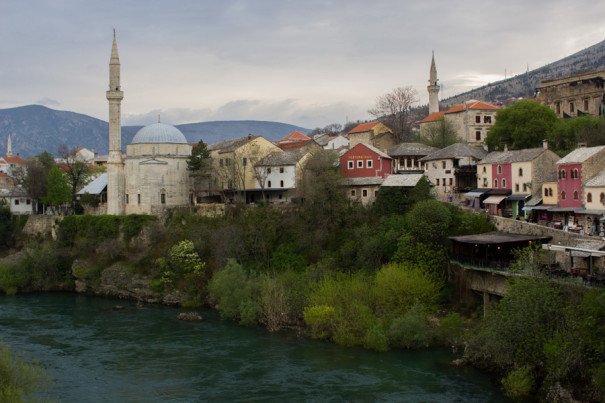
A Neutral Bar in a Divided City

A Neutral Bar in a Divided City
Wine in Mostar
I quickened my pace as I left the fishermen’s spot below the Ottoman bridge, seeking shelter from the rain that had just begun to fall and the incessant pickup artists that had appeared before sunset. I walked into the first bar I stumbled upon after climbing the stone stairs to the cobblestoned alley.
It was a typical pub in an atypical setting, and at first that was the only thing that struck me. With its small stage, wooden tables, stickers from unknown blues bands, and ceilings covered in flags from all over the world, The Black Dog Pub looked like any other expat pub in the Balkans, but it didn’t look like any other bar in Mostar. The area surrounding the bridge, the Stari Most, had been destroyed during the Croat-Bosniak War in the early 90s and was still being rebuilt. It seemed to consist mainly of touristy wannabe Ottoman restaurants in rebuilt Turkish houses. The pub was a stark departure from that.
I took a seat in the bar and ordered a glass of white wine, quickly realizing I should have gone for a craft beer from the local Old Bridgz Brewery instead. The bartender Stephen struck up conversation; he was the owner of the bar, a 40-something expat from Seattle. He’d come to the country in 1994 to work in emergency medicine, married a woman when the war was over, and decided to stay after the divorce.
Unlike the rest of the city, the bar was busy. I asked Stephen how he managed to draw such a crowd despite the tourist season being months away and the streets nearly empty.
“Locals come here, it’s the only foreign-owned bar in the city,” he shrugged before leaving the bar to welcome some regulars.
It took me a moment to connect the dots. I knew Mostar was divided by more than the river that cut though the city; the ethnic and religious divide runs much deeper than the Neretva. More than 20 years after the war ended, the west bank is still held by Croats while Muslim Bosniaks hold the east. Both parties have resisted foreign pressure and initiatives to reintegrate. The city, with a population of just over 100,000, has two universities, two postal networks, two electricity companies, two phone networks, and two utility services. As Stephen told me when he returned, it also has two sets of bars: those that Croats frequent, and those that mainly cater to the Muslim Bosniaks. He welcomed everyone, and that’s why he was always busy, he said. A young guy behind the bar nodded supportingly.
“Because the owner is foreign, not Muslim or Croatian, everyone can come here and they don’t need to worry about anything,” the bartender, Saša, an Orthodox Serb, said. “It’s different times now; the city isn’t as divided, but sometimes we still worry when we go to a bar on the other side of the river. We still go, but we do worry.” The Black Dog Pub is popular for another reason, he added when Stephen had gone to greet another regular; it’s one of only two or three bars that stay open throughout the winter.
I emptied my glass of wine and left the bar. The rain had increased while the pickup artists had either gotten lucky or gone home; the streets were all but empty. I paused for a moment when I crossed the bridge, its wet stones slippery from the rain. They were bright and clean, their pristine state revealing how new they were. The bridge had been rebuilt 10 years after it was destroyed by Croatian artillery shells. When it reopened in 2004, UNESCO hailed it as a symbol of reconciliation and peaceful coexistence. The cultural divide, which dated to long before the destruction of the bridge, would take longer to mend.